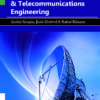The applications of electromagnetic fields are of great importance in such areas as radar and navigation, communications, information and communication technologies, industry and agriculture, medicine, etc. It is the interaction of moving charged particles (for example, electrons) with the electromagnetic field that is the cornerstone of electromagnetic phenomena.
This book provides readers with an in-depth understanding of electromagnetic field theory and its applications in a variety of fields. Electromagnetic fields are a unit advanced phenomenon, that transport energy and knowledge across space. Information can be imposed onto electromagnetic waves by human ingenuity, through various forms of modulation; however, this book will focus on the acquisition of information as electromagnetic waves are generated by materials or pass through materials. The book will also consider how energy is transferred to materials by electromagnetic fields.
The present book deals with vistas of developing the microwave sources of electromagnetic oscillations whose operation is based on the interaction of an electron beam with the slowed-down electromagnetic wave of electrodynamic structure, i.e., there exists Cherenkov’s radiation mechanism. In this book, a detailed model and analysis are shown and the proposed scheme is capable of efficiently separating magnetic particles with different permeability and sizes. The method shows the simplest way to separate economical particles and will probably be enforced in biological and chemical systems. The book succeeds with electromagnetic field interaction with metamaterials; compact design of dual-band fractal ring antenna for WiMAX and WLAN applications; research on non-contact weak current detection technology; and design optimization of axial flux permanent magnet (AFP) synchronous machine using 3D FEM analysis.
In the concluding section of this book, a survey of the different recent state of the art techniques that have been deployed in the design of antennas that can perform excellently for cognitive radio application is carried out. Cognitive radio system fundamentals and antenna requirements for its smooth operations are also discussed. The performance of the antennas designed by various techniques in terms of, the radiation pattern, VSWR/Return loss, peak gain, the radiation efficiency is discussed. Issues relating to the design techniques and some factors to consider when designing a suitable antenna for the cognitive radio system also highlighted.
This book will be of great help to students, engineers, innovators, and researchers working in a wide variety of fields.














Reviews
There are no reviews yet.